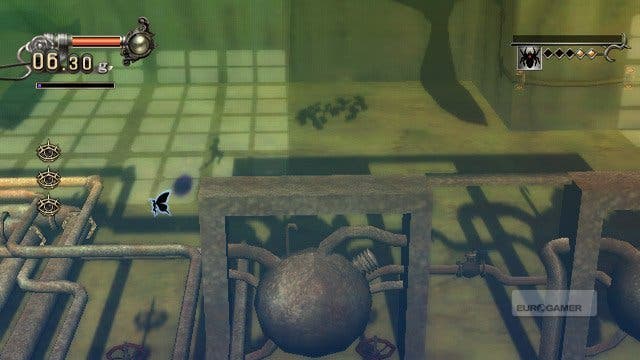A Shadow’s Tale
Pretty vacant.
In a gaming landscape often mired in the noisy brown mindset of the angry adolescent shooter, it's not that difficult to stand out. You either go bright and colourful, or you go quiet and arty. Either approach will get eyes pointed in your direction, but it helps if you have a game worthy of the attention in the first place.
That's where A Shadow's Tale stumbles. A gentle, oil-painty sort of platform game, it hinges on one simple twist: you're playing as a shadow. At the start of the game, your character – simply called Boy – is suspended in mid-air at the top of a giant tower. A creepy executioner approaches, but his blade severs your shadow, not your head. He grabs this ephemeral off-cut and tosses it over the side.
Here's where you come in. You have to ascend the tower to be reunited with your physical body. As a shadow, you can walk, climb and jump on other shadows, but fall into nothingness if there's only light and solid ground beneath you. The result is, quite blatantly, the original Prince of Persia remade in the style of ICO.
Despite the distractingly obvious inspirations, the shadow play is an undeniably clever idea, and one that makes the early stages an enjoyable head trip. We're so used to watching the foreground that it takes some time to train your eyes to look deeper into the image to see both your character and the environment he can traverse. There are plenty of "Oooh" moments as you realise you can jog across scenery that would normally be impassable.
Being a shadow brings with it a few unique features, too. Obviously, you can't interact with the physical world, but you're accompanied by Spangle, an unexplained fairy creature who can locate and grab movable objects, which in turn shift the shadows around. There are also times when you're able to move the light source directly, vertically or horizontally, lengthening and shortening the available shadow platforms to reach new areas. Later, light gates let you slip through into physical reality for brief periods.

The foundations of an innovative platformer are laid, but the game never builds on its potential. Once you've got used to looking "through" the game to the shadow layer, it quickly becomes apparent that beneath the concept is a fairly ordinary platform game. Ultimately, regardless of which puzzle type is thrown at you, you're just throwing switches to move platforms, which is hardly ground-breaking stuff. With only two axes to move the light along, and dead ends where Spangle use is clearly required, solutions are hardly taxing either.
Unlike Braid, which took a simple idea and then extrapolated it into an escalating crescendo of brain-melting puzzles, A Shadow's Tale never truly grapples with the possibilities of playing with light and shadow, instead using them to obscure tired old clichés. When you're jumping over your hundredth buzz saw blade, or waiting to dash past another row of alternating gas vents, the fact that they're technically the shadows of physical hazards doesn't really make any practical difference.
The game is weak in other areas as well. Combat is simplistic and sticky, relying on a rudimentary three-hit combo once you've found a sword. Enemies are faster than you, have longer reach and do a lot of damage, so each clumsy encounter with a shadowy spider or lizard is more likely to end in frustration than excitement. Master the timing, however, and they become pathetically easy. Each enemy defeated squirts out a small amount of health and some purple XP orbs, but since levelling up only improves your attack strength by tiny increments, you'll barely notice the difference.








